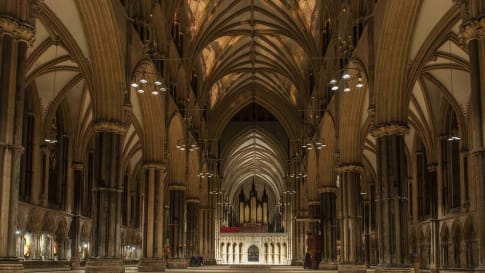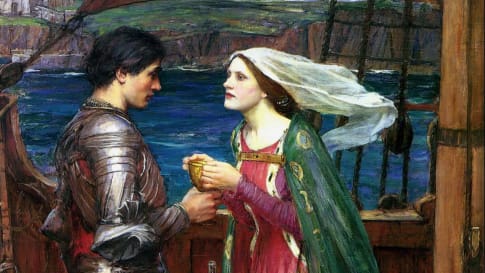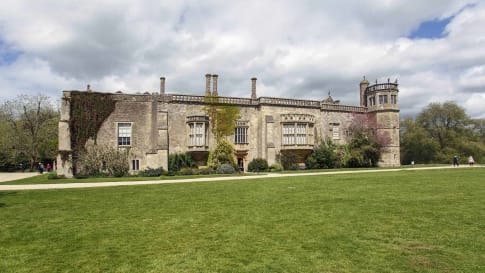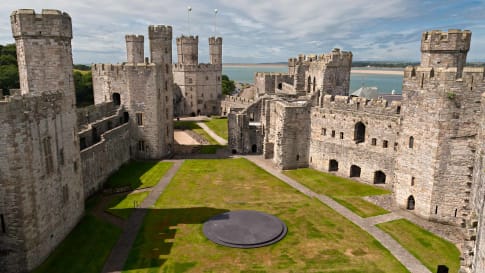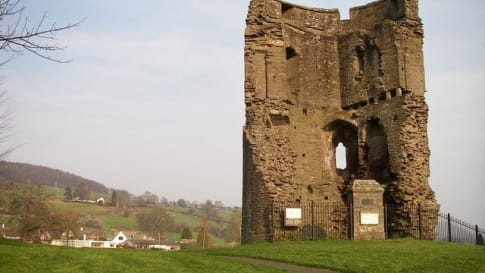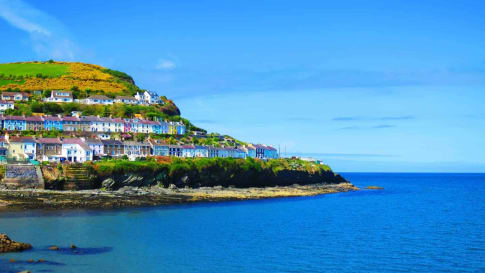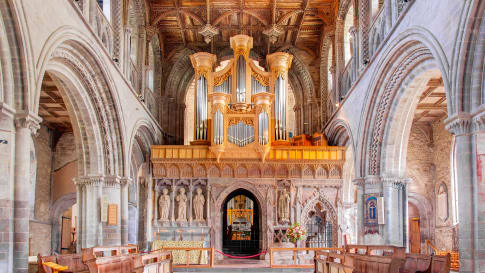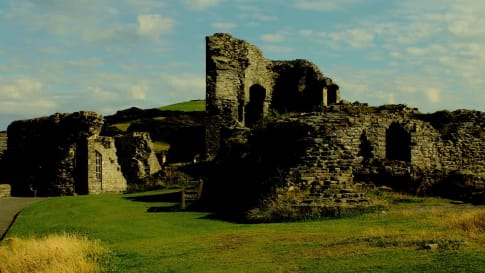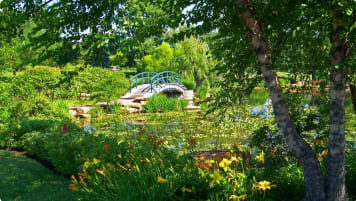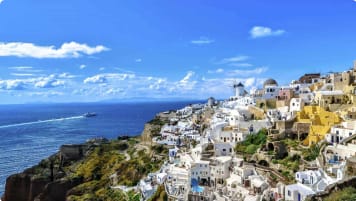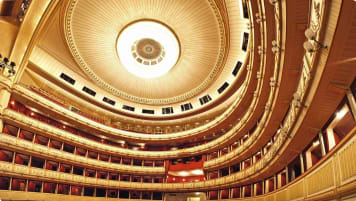Small group tours Medieval England
A small group tour of England focused on Medieval England and Wales. Spend 21 days on this escorted tour with tour director and local guides travelling from Canterbury to Cambridge, passing through Winchester, Salisbury, Bristol, Hereford and Norwich along the way. Castles, villages, Cathedrals and churches all feature in the Medieval landscapes visited.
From $13,961CAD
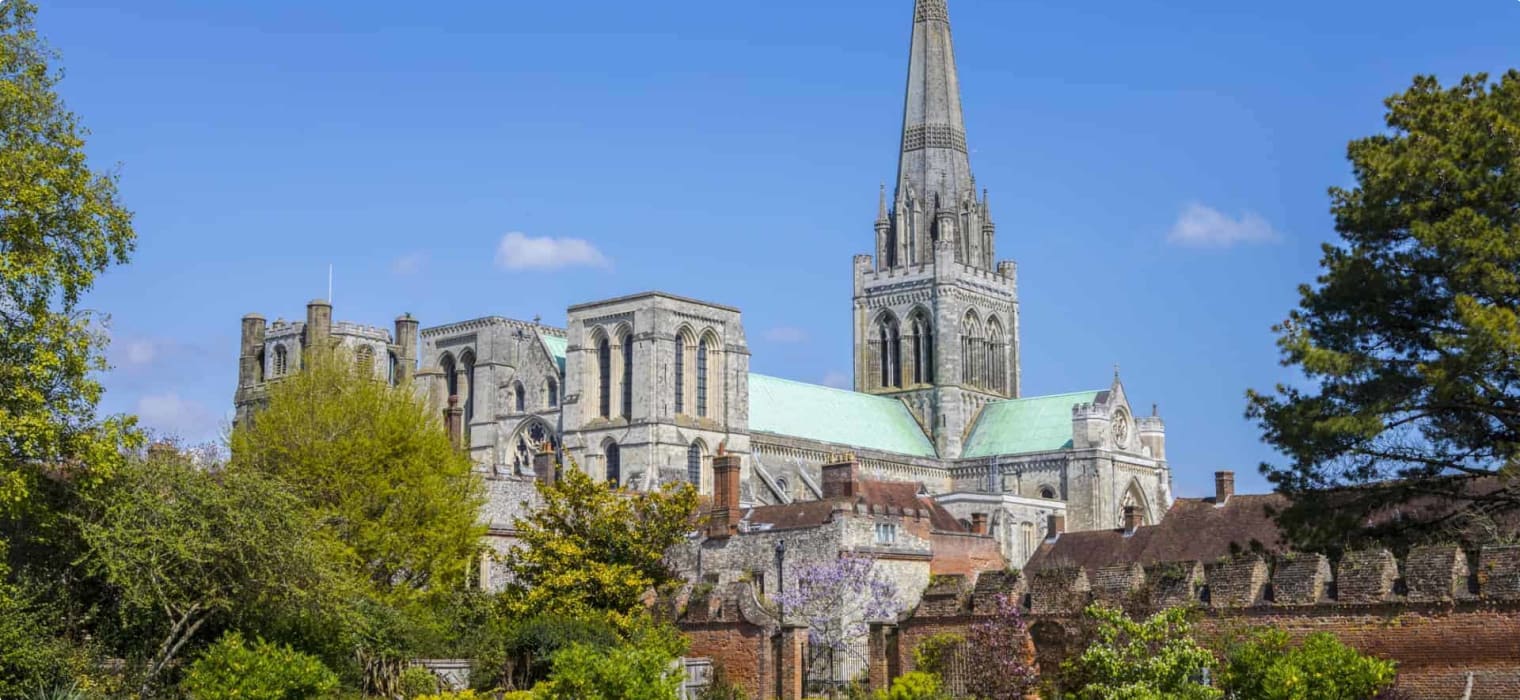
Highlights
- 1. Explore the remains of once great religious foundations such as Tintern Abbey.
- 2. Be astounded by the size and complexity of castles such as Caerphilly and Bodiam.
- 3. Wander through village streets largely unchanged since 1400.
- 4. Learn about the lives of real people from the period when we spend time in Norfolk visiting the homes where the Paston family lived and wrote each other hundreds of letters, as well as the churches where they worshipped and were buried.
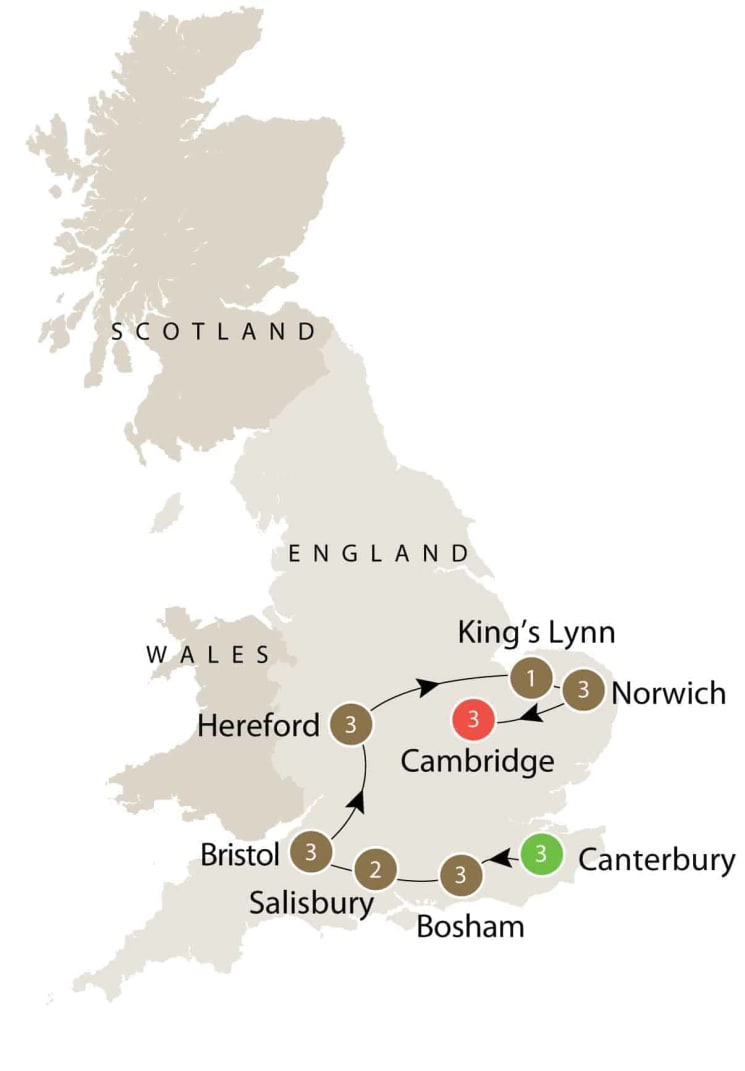
Departure Dates
| Departure Date | Price |
|---|---|
| 07 September 2025 Ends 28 September 2025 • 22 days $13,961 Twin $15,594 Single Available | Selected |
| 19 April 2026 Ends 10 May 2026 • 22 days $14,415 Twin $16,047 Single Available | |
| 06 September 2026 Ends 27 September 2026 • 22 days $14,415 Twin $16,047 Single Available | |
| 18 April 2027 Ends 09 May 2027 • days $14,896 Twin $16,591 Single Available | |
| 05 September 2027 Ends 26 September 2027 • days $14,896 Twin $16,591 Single Available |
Medieval England Small Group Tour
This small group tour has been especially designed for the active mature-aged and senior traveller, joining this tour as a couple or solo traveller with an interest in exploring what remains of Medieval England and Wales. On this worthwhile journey, we will discover how those years laid the foundation for modern Britain. We’ll concentrate on the period between AD 800, around seven centuries after Hadrian's Wall was erected to mark the northern limit of Britain, and AD 1500. We will discover--through guided tours of medieval castles and cathedrals, sightseeing tours of the beautiful landscapes and natural beauty of the British Isles, and walking and city tours to view the modern world--just how much the country has changed over the centuries.
Despite invasions, civil wars and periodic outbreaks of plague, southern England prospered during the medieval period, and evidence of that prosperity can still be uncovered in towns, villages, farmland and trading ports. We tend to think of castles and cathedrals when we think of what still remain standing from the medieval world, but these are just the more obvious remains, the remains that often tower over modern towns and villages. If we look carefully, there is much more that can be discovered.
On this unique travel experience we will spend time uncovering details of how people lived, what they believed, what they ate, how they earned a living and how some became very rich, while others lived lives of grinding poverty. We will also look at how the people were governed and how this changed over the centuries. Join us on this journey of exploration into the medieval world.
Spend 21 days travelling with like-minded travellers on an educational program that takes you in a great circle from Canterbury to Cambridge, passing through Winchester, Salisbury, Bristol, Hereford and Norwich along the way. We travel through some of the most spectacular destinations in England and Wales, visiting amazing cities as well as tiny villages and abandoned religious foundations. There is so much to see on this trip that we have had to be selective, but by the end of the program you will have uncovered many of the highlights still remaining from this amazing period of change and development. Similar to other Odyssey Traveller tours, you will be accompanied by a Program Leader and local guides.
Medieval England and Wales Small Group Tour Itinerary
Castles
The Norman invasion of 1066 began the great era of castle building in England and Wales. These defensive fortifications continued to be built to impress or subdue local populations until the introduction of the canon made them more or less redundant. Some castles have fallen into ruins, some, having undergone various restorations, are still lived in, while others have been converted into museums. The castles we visit give us a good idea of what life was like for the warlike aristocracy and their many dependents.
Our program includes visits to castles in Canterbury, Norwich and Winchester as well as others in smaller centres. Moated Bodiam Castle, now owned by the National Trust, was built in the late 14th century and, although actually a ruin, still looks most impressive and gives an excellent idea of castle design. We will also tour Caerphilly Castle in Wales, one of Britain’s most impressive. This massive structure, built in 1268 in an attempt to keep the Welsh under control, is the second largest castle in Britain. Although the much smaller Stokesay Castle in Shropshire started life as a fortified manor house, it still provides an impressive array of 13th century towers and a magnificent Great Hall.
Cathedrals
The Medieval period was a much more religious one than our own and the proliferation of churches, monasteries and abbeys reflects the era’s belief in a very real and personal God. Life was short, insecure and often miserable. The next world represented a means of escape into a better life and donations to religious foundations were often seen as one way of ensuring entry into that better life. The cathedrals and churches we visit on a walking tour provide an enduring legacy of the people’s faith and to their incredible craftsmanship. They provide us with some of the best examples of medieval art and architecture still to be found in Britain.
Naturally we spend time in Canterbury Cathedral where Thomas Becket was murdered in 1170. Even without this famous murder Canterbury Cathedral would still be worth visiting. The original foundations date back to 597 when Augustine arrived on the Kentish coast with orders from the pope to re-establish the the Roman church in England. Other cathedrals we will enjoy visiting include those at Wells, Salisbury, Bristol, Hereford, Leicester and Norwich.
And much more…
Medieval people did not only build massive castles and grand cathedrals. Norfolk is studded with many beautiful small churches built by the very wealthy wool merchants who lived in the area. These churches still contain some of England’s best reserved painted panels, carvings and stained glass. Although Henry VIII dissolved the monasteries after 1536, there are still many remnants remaining as magnificent ruins or through their conversion to other uses. A visit to Tintern Abbey and Walsingham Priory helps to remind us of just how rich and powerful these institutions once were.
Although the castles, cathedrals and abbey ruins often dominate our vision of the medieval world, we can still visit a number of smaller but equally significant structures. Still surviving are a number of the great medieval barns where grain, paid as tithes or taxes, was stored for religious foundations or for the king. A number of these “agricultural cathedrals” will be included on our tour, as will farm houses, manor houses, inns, shops and the houses of wealthy town folk who could afford to build substantial dwellings. Lavenham in Norfolk was once one of the wealthiest towns in England. With the decline in the wool trade Lavenham was left behind and a consequent lack of development has resulted in the preservation of many fine buildings from the 14th and 15th century.
Take this opportunity to go on an adventure as we travel forth from our comfortable accommodation and beyond. Explore ancient houses, eat in historic inns, wander through a medieval town, sit quietly in a tiny village church to admire the painted rood scenes, and develop a better understanding of life for both rich and poor during the medieval period.
For more details, click the ‘Top 5’ or ‘Itinerary’ buttons above! If you’re keen to experience this tour, please call or send an email. Or, to book, simply fill in the form on the right-hand side of this page.
To help you plan your journey, and for more information, the following articles may be of interest:
- British Village Icons
- Life in the Medieval British Village
- British Churches Through the Years
- Roman Roads in Britain
- History of Wales
- Other articles on the British Isles
If you're more interested in visiting St Paul's Cathedral, Windsor Castle and St George's Chapel, or the landscapes of the Cotswolds, don't click away! Odyssey Traveller offers a number of tours of Great Britain, ranging from basic sightseeing tours ideal for your first trip, to unique experiences that delve deep in to Britain's history and culture.
Articles published by Odyssey helping to prepare for this Medieval England Tour
The following list of articles published by Odyssey Traveller for mature aged and senior travellers to maximise their knowledge and enjoyment of England when visiting;
- Medieval British life
- Great Britain Travel tips
- Understanding British Churches
- English Village History
- Britain's National Trust.
- History of English Cathedrals: A Comprehensive Guide
External articles to assist you on your visit to England
- History of England: - PODCASTS
- Tudor England
- Anglo- Saxon migration
- Civil wars that influenced medieval Britain
Other Odyssey Tours
Small group tour of Medieval England is only one of many tours of Britain offered by Odyssey Traveller. For more details, click the ‘Top 5’ or ‘Itinerary’ buttons above! If you’re keen to experience this tour, please call or send an email. Or, to book, simply fill in the form on the right hand side of this page.
Gallery
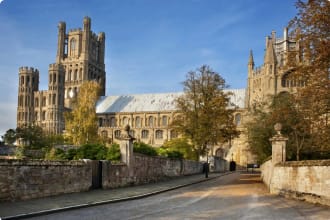
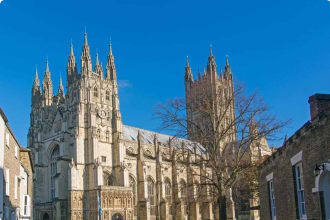
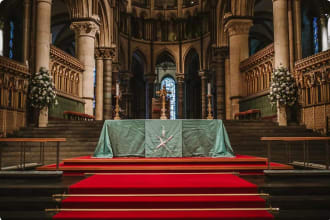
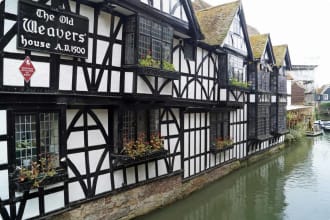

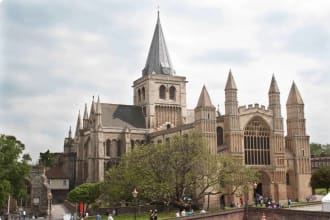
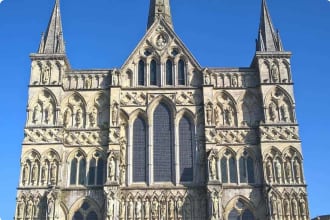
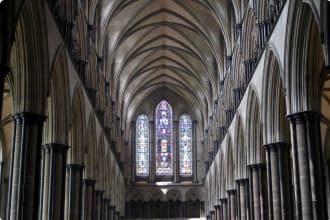
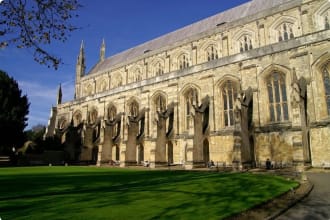
Itinerary
22 days
Day 1: Canterbury
Arrive in Canterbury and make your own way to our accommodation where we will stay for the next three nights.
In the afternoon, you will meet as a group with your Odyssey Program Leader for a tour briefing, followed by a welcome dinner in a local restaurant.
Day 2: Canterbury
Today we will discover something about the medieval period and become acquainted with the city of Canterbury.
We will listen to a lecture on Medieval Britain, followed by a guided city tour including the cathedral precinct and Canterbury Castle.
We will enjoy lunch at the historic, half timbered “The Weavers,” one of the most photographed buildings in Canterbury.
Remainder of the day can be spent at your leisure.
Dinner is at own expense tonight.
Day 3: Canterbury
Today we take a coach tour around the region to include Leeds Castle (or Hever Castle), Ightham Mote and Rochester.
Leeds Castle, begun in the 12th century, has been continuously inhabited ever since, though its present appearance is the result of many years of rebuilding and extension. Many believe this to be the most beautiful castle in England.
Ightham Mote is a medieval moated manor house near Sevenoaks which was built nearly 700 years ago and is surrounded by gardens. Now owned by the National Trust this beautiful house has been lived in by medieval knights, courtiers to Henry VIII and high-society Victorians.
Rochester, on the River Medway, has a rich naval history. In Rochester Castle, England’s tallest keep provides views over the river, and the town’s medieval history is still visible with the original city walls on view in the High Street.
Return to hotel in Canterbury for the night.
Dinner tonight is at your own expense.
Day 4: Canterbury - Rye - Steyning - Bosham
We leave Canterbury and travel to Bosham where we spend three nights.
Today our touring coach takes us to the coastal village of Bosham via Rye, Bodiam Castle and the village of Steyning.
The ancient fortified town of Rye developed in the 12th and 13th centuries as one most important of the Chanel ports. In the 16th century, however, the port began to silt up and the town is now 3 Km inland. Rye was burnt to the ground by the French in 1377 but was subsequently rebuilt.
There is the possibility of having coffee or lunch in The Mermaid Inn, rebuilt in 1420.
In the afternoon we travel to Bodiam Castle, one of Britain’s most romantic and picturesque castles. The castle was built in the late 14th century and, although now a ruin, retains its original wooden portcullis, spiral staircase, battlements and moat.
The lovely little town of Steyning is packed with timber framed buildings from the Tudor period and earlier. From Saxon times Steyning was an important port and boat building centre and Ethelwulf, father to King Alfred, was buried there in 855. The 12th century church gives evidence of the town’s prosperity before the river silted up and put and end to its days as a port. We will have time to walk through the town and explore some of its medieval buildings.
Tonight, dinner will be in our Bosham hotel.
Day 5: Bosham - Chicester - Bosham
Bosham is a small village on the coast not far from Chichester. Although now tiny, Bosham was an important centre in Saxon times. According to legend it was here that King Canute stood on the shore and commanded the waves to go back out, and here that his young daughter was drowned in a nearby stream. She is supposed to have been buried in the village church. It is recorded on the Bayeux Tapestry that it was from Bosham that King Harold set out on his ill-fated voyage to France and a copy of this part of the tapestry can be viewed in the church.
This morning we take time to visit Bosham’s Saxon church before continuing on into Chichester to spend some time exploring the town and the cathedral with a guide.
In the afternoon we visit the Weald and Down Open-Air Museum. Here traditional buildings in a rural landscape, tell the story of the men, women and children who lived and worked in them over a 600-year period. Many of the exhibit houses are furnished to recreate historic domestic interiors.
We return to Bosham for dinner.
Day 6: Bosham - Portsmouth - Isle of Wight - Bosham
Today our coach takes us to Portsmouth where we board the ferry for the Isle of Wight. Here we visit Carisbrooke Castle. Carisbrooke Castle has been a centre of power for over 1000 years, first as a Saxon fortress and later as a Norman castle. It was extensively modified during the medieval period. The Isle of Wight was given to the de Redvers family by Henry I in 1100 and for almost 200 years it was ruled by the family as an autonomous fiefdom owing no allegiance to the English crown. Eventually the crown took the island and the castle back when Isabella, the last of the de Redvers family, died in 1293. (We will learn much more about Isabella’s extraordinary life when we visit the castle.)
We return to the mainland in the afternoon and, time permitting, visit the Mary Rose Museum in Portsmouth before returning to Bosham for the night.
Day 7: Bosham - Winchester - Salisbury
This morning our coach takes us to Salisbury via the cathedral city of Winchester. We spend two nights in Salisbury.
Winchester was the capital of the ancient kingdom of Wessex and the headquarters of the Saxon kings right up until the time of the Norman Conquest. A church was built on the site of the cathedral in 648 but the current building was not begun until 1079. William I built one of his first castles in Winchester but the Great Hall, erected in 1235 to replace the original, is the only surviving part of the Norman castle. It now houses a 13th century version of King Arthur’s legendary round table.
We have time for a guided tour of the city centre including visits to the cathedral, the Great Hall and the Westgate Museum, before continuing our journey to Salisbury where we stay for the next two nights.
Day 8: Salisbury
This morning we have a tour of Salisbury with included visits to the cathedral, the church of St Thomas and the High Street.
The “new” city of Salisbury was founded in 1220 when the hilltop settlement of Old Sarum was abandoned as too cold and windy. The cathedral, with the tallest surviving spire in England, was mostly built in the early 13th century over a remarkably short period of time. We will also visit the church of St Thomas which has a lovely carved timber roof and a 15th century Doom painting which shows Christ sitting in judgement while demons seize the damned. (One more incentive for making a contribution to church funds.)
The afternoon is at leisure and you will have time to stroll through the streets discovering medieval buildings hidden behind Georgian facades.
Overnight Salisbury.
Day 9: Salisbury - Cleeve Abbey - Bristol
This morning we drive to Bristol via Cleeve Abbey near Washford. We spend three nights in Bristol.
Cleeve Abbey provides the visitor with some of the finest surviving Cistercian cloister buildings in England. Although the abbey church was destroyed by Henry VIII during the dissolution in 1536, the cloister buildings, including the gatehouse and the 15th century refectory with its glorious angel roof and 13th century heraldic tiles, have survived remarkably intact. The great dormitory is one of the best examples in the country, and an exhibition and virtual tour tells the story of the abbey and daily life for the holy men who once inhabited it.
We continue to Bristol in the afternoon for some leisure time followed by dinner in a local restaurant.
Day 10: Bristol
This morning we have a guided tour of medieval Bristol including visits to the magnificent St Mary Redcliffe Church, built in the 14th century and claimed by Queen Elizabeth I to be “the fairest in England” and to the equally magnificent cathedral. The cathedral was begun in 1140 but work continued over the next 700 years. Humorous medieval carvings abound and there is a fine set of wooden misericords in the choir.
In the afternoon we drive to Wells with time to explore the wonderful cathedral and its surrounding precinct. Wells is said to be England’s smallest city and shares its bishopric with nearby Bath. The cathedral was begun in the 1100s and is famous for its elaborate West Front and the amazing “scissor arches” installed in 1338 to support the tower. The nearby Vicars’ Close, built for the Vicars’ Choir in the 14th century is one of the oldest complete streets in Europe.
We return to Bristol for the night. Dinner is at your own expense.
Day 11: Bristol - Cosmeston - Bristol
Today we venture across the Bristol Channel into Wales to visit Cosmeston Village. This is a reconstructed “living” museum of medieval village life based on archeological remains from the area. The original village developed in the 12th century but by the 15th century had almost completely disappeared. It is possible that a combination of plague and local warfare may have caused the village to become unviable.
In the afternoon we return to Bristol to visit a replica of John Cabot’s carrack, The Matthew. In 1497 the Italian John Cabot (Giovanni Caboto) sailed from Bristol on his historic voyage to America. From then on Bristol flourished as it became the main port for transatlantic trade, particularly in wine, tobacco and slaves. We also have an introduction to the life and times of English cloth merchants working in London, Calais and Bruges through a unique set of letters written by the Cely brothers written between 1472 and 1488.
Dinner tonight is at your own expense.
Day 12: Bristol - Evesham - Hereford
Today we travel to Hereford via Evesham. We spend three nights in Hereford.
In Evesham we stop to view the Round House, a merchant’s house museum that looks at the growing importance of trade and the merchant class in England. We also visit the Almonry Museum which looks at support for the poor and aged in late medieval times.
Today we take lunch in Evesham’s early 15th century, National Trust owned, Fleece Inn before heading out to Middle Littleton to visit the National Trust’s tithe barn. Little Middleton has one of the finest tithe barns in the country. It is dated to the 13th or 14th century and was once used to collect tithes in grain, 10 percent of all farm produce, for the monks of local Evesham Abbey. The barn is built of stone and stands 130 feet long and 42 feet wide. This magnificent structure is an enduring reminder of the power of the medieval church.
From Evesham we travel west to Hereford on the Welsh border.
This afternoon we have a guided tour of Hereford, once the capital of the Saxon kingdom of West Mercia. Hereford Cathedral’s most celebrated treasure is the Mappa Mundi, the Map of World, drawn in 1290 by clergyman Richard of Hardingham. The world is depicted here based on Biblical principles with Jerusalem at the centre of the map and monsters inhabiting the margins of the world. The cathedral is also the proud possessor of a chained library. The most important book in the library is an 8th century copy of the gospels, the oldest of the 229 medieval manuscripts in the chained library.
Day 13: Hereford - Wales - Hereford
We leave England again this morning and spend the day in Wales, before returning to Hereford in the evening. Our journey today takes us to Caerphilly Castle, Tintern Abbey and the Monmouth.
Caerphilly Castle is the second largest castle in Britain and the largest in Wales. It was built from 1268 by Marcher Lord Gilbert de Clare in response to the threat posed by the Welsh prince, Llewelyn ap Grufford. On Llewelyn’s death the castle was transformed into a palatial home. In the early 20th century the fabulously wealthy 4th Marquis of Bute spent the equivalent of many millions of dollars in an imaginative reconstruction of the castle so that now we can get a good grip on just how well the castle would have functioned when it was first built.
Tintern Abbey was founded in 1131 by Cistercian monks. By the 14th century Tintern was the richest abbey in Wales, but like all other abbeys in the country, it was dissolved by Henry VII in 1536. Ever since the 18th century visitors have been enchanted by Tintern’s romantic ruins set in the steep and wooded Wye Valley. Turner came here to paint and Wordsworth’s sonnet, “Lines composed a few miles above Tintern Abbey” embody his romantic view of the ruins.
Monmouth, although originally the site of a small Roman fort, became fully established after 1067 when the Normans built a castle there. In 1300 city walls were built and the bridge over the River Monnow was fortified. This bridge is now pedestrianised and we’ll be able to walk across in the footsteps of so many before us.
We return to Hereford for dinner.
Day 14: Hereford - Ludlow - Woebley - Hereford
This morning we travel north towards Ludlow, Stokesay Castle, and Knighton before heading back towards Hereford via Woebley and Mortimer’s Cross.
At Knighton you will be standing very close to Offa’s Dyke, the famous earth wall thought to have been built during the reign of Offa, king of Mercia between 757 and 796. The dyke runs along the border between England and Wales and is thought to have been either for defensive purposes or for Offa to simply show his power.
Ludlow and the village of Woebley have many 15th century houses still in use and provide an excellent introduction to town life during that century. Mortimer’s Cross, close to Ludlow, allows us time to consider the impact of the Hundred Year’s War and the Wars of the Roses on the lives of ordinary people.
According to “English Heritage” Stokesay Castle is, “quite simply the finest and best preserved fortified medieval manor house in England.” It was built in the 1280s by a fabulously wealthy wool merchant called Lawrence of Ludlow who took advantage of the recent peace between England and Wales to construct a comfortable dwelling place without the need for excessive fortifications.
We spend the night in Hereford.
Day 15: Hereford - Worcester - Stratford - King's Lynn
This morning we leave Hereford and drive east towards King’s Lynn via Worcester and Stratford upon Avon.
Worcester was well established as an important centre by the Saxon period and it was during King Alfred’s reign that the lords of Mercia fortified the city walls. A bishopric was established there around 680 and Worcester grew into a centre for monastic learning and of church power. The last Saxon bishop, Wulfstan, was an important church reformer who managed to stay in his post even after the Norman conquest. The current cathedral building was begun in the 13th century but the nave and central tower were not completed until 1370. There are a number of interesting tombs within the cathedral including that of “bad” King John. It is a masterpiece of medieval carving and can be found in front of the altar. Prince Arthur, the older brother of Henry VIII, who died at just fifteen, is also buried here. His remains can be found in the chantry chapel to the south of the altar and this is said to be one of the reasons the cathedral escaped damage during Henry’s suppression of the Roman Catholic Church.
In Worcester we’ll find time to visit the Cathedral as well as The Greyfriars Museum, established in a building originally built in by a wealthy merchant in 1418.
From Worcester we’ll continue to Stratford upon Avon, most famous as the birthplace of William Shakespeare but well established by the early medieval period. Here we’ll have time to explore the ancient centre on our own and visit some of the houses associated with Shakespeare and his family.
From Stratford we’ll drive to King’s Lynn where we’ll spend just one night.
Dinner at hotel or a local restaurant.
Day 16: King's Lynn - Norwich
Today we begin our exploration of Norfolk with a guided tour of King’s Lynn, once an important member of the Hanseatic (trading) League, before continuing to Norwich where we’ll spend the next three nights.
King’s Lynn, formerly known as Bishop’s Lynn before Henry VIII made a name change expedient, was one of the richest trading ports in England during the medieval period. It was in Bishop’s Lynn that Margery Kempe was born in 1373. Kempe, the daughter of a wealthy merchant, was a mystic who went on many pilgrimages, even getting as far as Jerusalem, and composed what is considered to be the first autobiography in the English language. A carving of Margery’s head can be seen in the Lynn Minster.
From King’s Lynn we’ll take a circuitous route to Norwich, visiting a number of religious foundations and churches along the way. Time permitting these will include the church of St Mary Magdalene at Wiggenhall, Castle Acre Priory, Walsingham Abbey and St Peter and Paul church at Salle.
We will spend the night in Norwich, with dinner at a local restaurant.
Day 17: Norwich - Paston - Caister - Great Yarmouth - Norwich
Norfolk was a wealthy wool trading region during the medieval period and this can be seen through the number of manor houses, churches and religious foundations which were built. Today we concentrate on a number of places and buildings connected with the wealthy Paston family, famous for the many letters written between family member which still exist, and which tell us so much about the period. Many of these were written by wives and mothers of the family and shed particular light on the role of women.
Today we travel to Paston to visit St Margaret’s Church, built in the 1300s. It features two striking 14th century wall paintings and a number of Paston family memorials. From here it is a short distance to Bacton where we visit the Priory Ruins. The Priory was built in 1113 AD by William de Glanville and was home to the Cluniacs, the Black Monks who purchased a piece of the “True Cross” ensuring that their priory became an important pilgrimage site. Pilgrims to the priory included Henry III.
From Bacton we travel to Mautby to visit St Peter and Paul Church, a small building with an interesting round tower. It is the burial place of Margaret Paston, one of the letter writers, who died in 1484. We continue to Caister-on-Sea to visit Caister Castle, an impressive moated brick quadrangle fortress founded by Sir John Fastolf in 1432. It features heavily in the Paston letters after being claimed by John Paston on the death of Sir John.
We lunch in Great Yarmouth where we should have time to explore some of its medieval features including one of the best-preserved medieval walls in England, the 12th century Tollhouse Gaol Museum and the Minster built in 1101.
On our way back to Norwich we call in at Ranworth church, home to three outstandingly important medieval treasures, the rood screen, an illuminated manuscript and the elaborately carved cantor’s desk.
Dinner tonight is at your own expense.
Day 18: Norwich
Today we have time to explore Norwich. We have introductory guided city tour in the morning followed by an afternoon at leisure to wander through the city’s cobbled streets, visit the cathedral founded in 1096 or explore the 12th century castle (a museum since 1894).
Dinner tonight at own expense.
Day 19: Norwich - Coggeshall - Cambridge
This morning we travel to Coggeshall on our way to Cambridge. We spend the next three nights in Cambridge.
Coggeshall has two of the finest medieval and Tudor buildings in the country. Dating from 1140 Coggeshall Grange Barn is the oldest surviving timber framed barn in Europe. Inside the barn can be found a display of historic farm wagons. The half-timbered merchant’s house, Paycocke’s, was built around 1500 and has beautifully panelled interiors.
In the afternoon we continue to Cambridge where we have the rest of the day at leisure.
Dinner tonight will be in a local restaurant.
Day 20: Cambridge
This morning we have a guided tour of Cambridge including admission to King’s College, founded by Henry VII in 1441.
Cambridge has been an important town since Roman times. Religious orders began to be established in the 11th century and then, in 1209, a breakaway group of scholars from Oxford established themselves in Cambridge. Peterhouse, the oldest of the university colleges was established in 1284. Since then a further thirty colleges have been added, the most recent in 1979. Student life dominates the city though it also serves as a thriving market centre for the surrounding district.
King’s College was founded in 1441 and work on the chapel began five years later. The chapel took seventy years to complete and is one of England’s finest examples of medieval architecture. Henry himself gave specific instructions about the specifications of the chapel, while the detailed design is thought to have been by master stonemason Reginald Ely.
In the afternoon we drive to Ely to visit the cathedral. The magnificent cathedral was begun in 1083 but took another 268 years to complete.
We return to Cambridge where dinner will be at your own expense.
Day 21: Cambridge - Lavenham - Cambridge
Today we travel to Lavenham for a self-guided tour to explore the main historical features. Once one of the wealthiest towns in the country, Lavenham is today famed for its wealth of surviving timber framed buildings. These make it one of the best-preserved medieval villages in England.
The Wool Hall is a notable half-timbered building, a tribute to the source of Lavenham’s great wealth. During the Middle Ages Lavenham was a thriving centre of the English wool trade, and the prosperous wool merchants are responsible for most of Lavenham’s memorable buildings, including the church of St. Peter and Paul, perhaps the finest “wool church” in the land.
In the afternoon we return to Cambridge for our farewell dinner in a local restaurant.
Day 22: Cambridge
Our program concludes this morning after breakfast.
Includes / Excludes
What’s included in our Tour
- 21 nights of accommodation in England, Wales, and Scotland.
- 21 breakfasts and 9 dinners.
- Touring by comfortable and modern mini-coach.
- All entry fees and services of local guides.
- Services of Tour Leader for the duration of tour.
- Detailed preparatory information.
What’s not included in our Tour
- Comprehensive travel insurance.
- Return international airfare and departure taxes.
- Airport transfers.
- Items of a personal nature, such as telephone calls and laundry.
Participants must be able to carry their own luggage, climb and descend stairs, be in good health, mobile and able to participate in 3-5 hours of physical activity per day, the equivalent of walking / hiking up to 8 kilometers per day on uneven ground.
Book now
Make it a private tour
Easing your journey
Crossing international borders with restrictions
The list of requirements to travel internationally has changed and will continue to change for several years. Odyssey is here to assist you in managing your way through these requirements:
For more information see our Crossing international borders with restrictions page.
Book With Confidence
If less than 30 days before your tour starts you are unable to travel as a result of Government travel restrictions, Odyssey Traveller will assist you with a date change, provide you with a credit or process a refund for your booking less any non-recoverable costs.
See Terms and conditions for details.
Peace of Mind Travel
The safety of our travellers, tour leader, local guide and support staff has always been our top priority and with the new guidelines for public health and safety for keeping safe for destinations around the world, we’ve developed our plan to give you peace of mind when travelling with us.
See Peace of Mind Travel for details.



